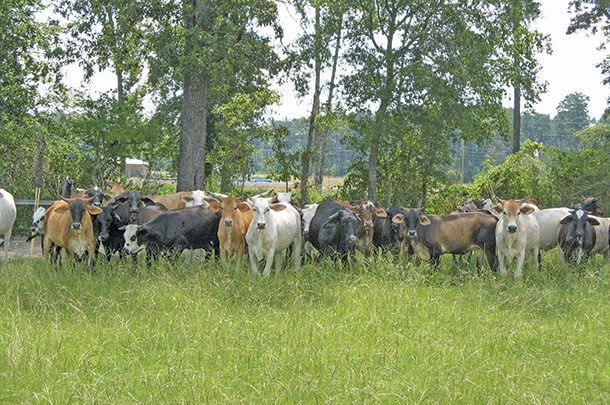Pinkeye, also known as infectious bovine keratoconjunctivitis (IBK), annually affects more than 10 million calves in the U.S. at an estimated economic loss of more than $150 million. The economic loss is due to decreased weight gain and treatment costs. The significant negative impact of pinkeye justifies management practices to help prevent the disease.
Two pinkeye symptoms most commonly observed are excessive weeping of the affected eye and eye closure due to pain. Infected animals normally attempt to avoid bright sunlight. The cornea becomes cloudy or white as the disease progresses and an ulcer frequently develops near the center. Infection may persist for several weeks.
Economic losses
“Pinkeye is painful,” says Heidi Ward, DVM, University of Arkansas Division of Agriculture. “When cattle are in pain, they are going to stop eating. Extreme pain can cause a lack of appetite, and they may stop eating because they can’t see to find the feed.”
Michelle Arnold, DVM, with the University of Kentucky, reported results from a field trial published in 2009 where weaning weights ranged from 9 to 27 pounds less in calves with pinkeye versus those that did not experience the disease. The average weight loss in these trials was 18 pounds. If 500-pound calves were selling for $1.50 per pound, an 18-pound weight loss would cost the producer approximately $27 per animal.
In addition to weight loss, calves with scars from pinkeye are often discounted at sale. Cost of pinkeye treatments, including antibiotics and labor, can amount to approximately $100 per head. Carcass quality is also negatively impacted by pinkeye. Yearlings that had pinkeye pre-weaning had less 12th rib fat depth, ribeye area and bodyweight than yearlings without evidence of pinkeye.
Vaccine efficacy
“Preventing pinkeye has proven difficult because so many factors contribute to its development,” says Arnold. “Contributing factors include environment, management, season of the year, concurrent diseases and the animal’s genetics and immune system. Pinkeye is highly contagious and can spread rapidly. Careful attention to contributing factors, especially face fly control, and prompt isolation of affected animals and effective treatments are necessary to prevent its spread.”
Pinkeye is primarily caused by the bacteria, Moraxella bovis. Moraxella bovoculi is also commonly identified in swabs taken from infected eyes, but it has not been verified by research as a causative agent. There are various strains of both M. bovis and M. bovoculi, which makes control by vaccination even more difficult.
“Currently, all available commercial pinkeye vaccines contain only M. bovis antigens with the exception of a vaccine marketed by Addison Biological Laboratory Inc. Addison’s vaccine contains eight different strains of M. bovoculi and is conditionally licensed since efficacy and potency have not been fully demonstrated,” says Craig McConnel, DVM, Washington State University Veterinary Medicine Extension.
Farm-specific vaccines are developed by Newport Laboratories Inc. and Addison that target both M. bovis and M. bovoculi strains. Target microorganisms are identified from swabs taken on infected eyes, and custom vaccines are developed to specifically target those species and strains. McConnel recommends only using these vaccine options in conjunction with veterinary input and evaluation of herd management practices due to the lack of field research that demonstrates efficacy.
Case study
A case study in Alabama provides an example of how pinkeye can negatively affect ranch profits. Erin Duke, a beef producer at Stockdale Farms in Munford, Alabama, experienced her first pinkeye incidence in 2017 when 75% of the cattle became infected. Stockdale Farms cattle are in a natural beef program, which meant that calves treated for pinkeye with antibiotics had to be sold in conventional markets. In 2017, only 120 calves escaped pinkeye and were sold as natural beef. Due to the reduction in natural beef calves, $2,000 was lost in market premiums.
“Matt Christjohn, DVM, ran diagnostics and discovered that a custom-made vaccine was needed. Our only solution was to administer a two-dose vaccine, which resulted in a very labor-intensive process,” says Duke. “It took six people nearly two days to treat all 400 head of cattle for the initial shot and another two days for the booster. The labor cost was approximately 1,000 dollars, and total cost of the two-dose vaccine was another 1,800 dollars.
After the first vaccine treatment followed by a booster shot, the pinkeye incidence rate dropped from 75 percent to less than 2 percent. The vaccination process was very challenging and costly, but I feel the results made the custom-made vaccine a necessity.”
Stockdale Farms switched to using the one-dose adjuvant within their custom-made pinkeye vaccine because it reduced time and labor by 50%. Vaccine cost was reduced to $1,300 and in addition, animal stress was reduced. The one-dose vaccine helped eliminate need for antibiotic treatment for pinkeye, which allowed more animals to remain in the premium natural beef program.
The above case study suggests that a proactive, preventive approach to pinkeye using custom-made vaccines may minimize outbreaks and reduce the need for antibiotic treatments even though efficacy has not been verified through research. Vaccination, however, is just one part of a pinkeye control program. It is also important to exercise face fly control, dust reduction and closed herds.









